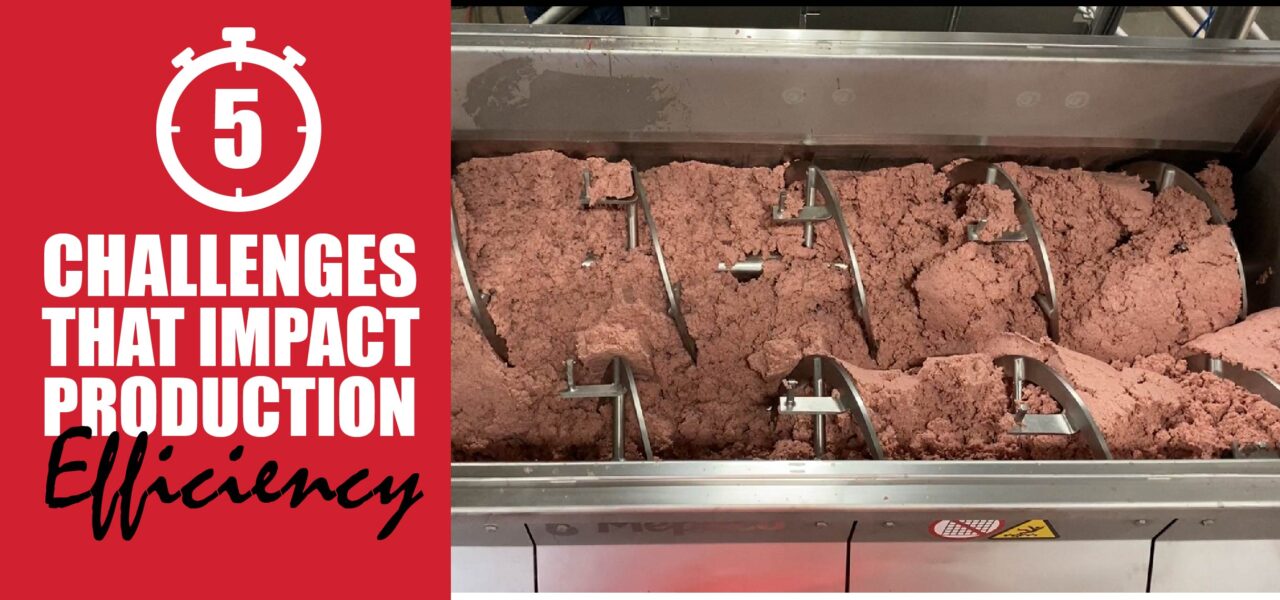
In a roundtable with field services, application engineers, and technical sales managers, these top 5 efficiency challenges are developed from experience with cooking, blending, and formulation projects in various food processing industries and installations.
1. Undersized equipment
Large conglomerate customers with continuous demand for their products often work with Mepaco on scale solutions with automated formulation, feeding, and unloading.
An example of a large-scale, large-volume solution is a surge bin system (link to video). Load cells measure product displacement (loss-in-weight method) and the mixers, blenders, and cookers in the line signal for raw materials in any given SKU. The surge metering screw conveyors deliver the correct quantity of product required through the primary grinder and then to the batch for final formulation. A surge bin system reduces labor and eliminates downtime with continuous, 24/7 large batch production.
2. Lack of Equipment Versatility
In other production scenarios, equipment size is not the answer, especially in quick-turn variable recipe batches. In an example of multi-recipe cooking versatility (link), ThermaBlend cookers offer blending and cooking in one piece of equipment and double production in a side-by-side system. The benefit of a side-by-side Thermablend system is flexibility in production scenarios with the ability to run two batches at once, staggered, or different batches in each cooker, all driven by production demand and recipe controls.
3. Poor Equipment or System Performance
Inefficiencies can also point to equipment performance (Overcoming the 5 Most Common Bottlenecks). Our field service experts offer that over-blending is commonly seen during efficiency audits as well as overtaxed agitators in mixers and blenders. In cookers, inefficiencies are also seen in worn scrapers, which impede production quality and are a liability to food safety.
4. Changeover
Multiple products that use the same processing vessel require extensive cleaning and sanitation, but some strategies can reduce the time and cost of sanitation. Take advantage of system and equipment training to ensure personnel understand the most efficient methods to maintain the equipment. Consider electropolished product surfaces, which is the highest-level finish that resists food attachment (video link) and customers have also reported reduced wastewater. Also, a CIP (Clean in Place) assist system may drastically reduce manual sanitation processes and labor.
5. Inefficient or ineffective loading and unloading
Some processors utilize buggies or vats to unload cookers and mixers. Other processors have come to Mepaco experiencing a need for increased production and efficiencies, requiring an automated loading and unloading solution. Screw conveyors, metering screws, or pump feeders may be planned into the systems for automated loading and unloading and sometimes even as a retrofit if the floor layout allows. Buffering mixers can be used for product accumulation when downstream equipment does not allow for product, and release product upon downstream demand.
Efficiency and automation themes are highlighted in our new e-book, “Automation Trends”.
It is a small commitment to consider an equipment or system audit, which often has an immediate return on investment. Inquire with sales to schedule an audit.
